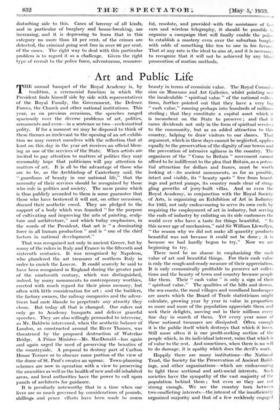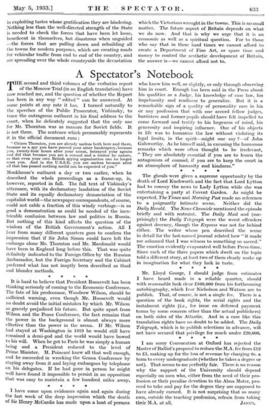Art and Public Life
THE annual banquet of the Royal Academy is, by tradition, a ceremonial function* in which the President finds himself side by side with, representative's of the Royal Fainily, the Government,' the Defenee Forces, the Church and other national institutions. This year, as on previous occasions, the speeches ,ranged spaciously over the diverse problems of art, politics, armaments and even—in a sentence or two—ecclesiastical polity. If for ninoment we may be disposed to think of these themes as irrelevant to the opening of an art exhibi- tion we may correct onrselves with the reflection that at least on this day in the year art receives an official bless- ing as one of the services of the State. When artists are invited to pay attention to matters'of politics they may reasonably hope ti* politicians will pay attention to matters of art. It Is all to the advantage of those who are to be, as the Archbishop of Canterbury said; the " guardians of beauty in our national life," that the necessity of their services should be recognized by those who rule in politics and society. The mere praise which is thus publicly accorded to them is some guarantee that those who have bestowed it will .not, on other occasions, discard their aesthetic creed. They are pledged to the support of a body which was founded " for the purpose of cultivating and iniproying the arts of painting, sculp ture and architecture," and which today emphasizes, in the words of the .President, that 'art is " a dominating' force in all human production " and is " one of the chief factors in national development."
That was recognized not only in ancient Greece, but by of the rulers in Italy and France in the fifteenth and sixteenth centuries, It was recognized by Napoleon, who plundered the art treasures . of northern, Italy in order to enrich the Louvre. It could scarcely be said to have been recognized in England during the greater part of the nineteenth century, which was distinguished, indeed, by many .monuments to contemporary worthies, erected with much regard for their. pious .memory, but often with little consideration for art ; and the builders, the factory owners, the railway. companies and the adver- tisers had carte blanche to perpetrate any- atrocity they chose. But today-,all that is -changed. Our rulers not, only go to Academy banquets. and deliver graceful, speeches. They are also willingly-persuaded to intervenp; as Mr. Baldwin intervened, when the aesthetic balance of London, as constructed around the -River Thames, was threatened by the proposed destruction of Waterloo Bridge. A Prime Minister—Mr. MacDonald—has again and again urged the need of preserving the beauties of the countryside. A proposal to destroy part of Carlton House Terrace or to obscure some portion of the view of the dome of St. Paul's creates an uproar. Town-planning schemes are now in operation with a view to preserving the amenities as well as the health of-new and old inhabited areas, and local authorities have the -power to call upon panels of architects for guidance. • . - It is peculiarly noteworthy that in a time when our lives are so much governed by considerations of pounds, shillings and pence efforts have been made ..to assess beauty interms of econishfic.value. The Royal Commis-. sion on Museums and Art Galleries, whilst pointing out the incalculable "spiritual Value" of the national collec- tions, further' pointed out that they_ have a very big " cash value," running perhaps into hundreds of millions sterling ; that they constitute a capital asset which it is incumbent on the State to preserve ; and that it earns dividends , not only in the form of spiritual services to the community, but as an added attraction to this country, helping to driV1 Visitors to our shores. That argument, which in these days cannot be neglected, applies equally to the preserVation of the dignity_of our towns and the 'prevention of intrusive ugliness in the Country. The organizers of the " come to Britain " movement cannot afford to be indifferent to the plea that Britain., as a poten- tial attraction for dollars and francs, must be Worth looking at–Lits ancient monuments, as far as possible, intact and visible, its " beauty spots " free from hoard- ings and petrol pumps, its country roads clear of strag- gling growths of jerry-built villas. And so even the Royal Academy, in conjunction with the ItOyal- Society of Arts, is organizing an- Exhibition Of Art :in Industry . for .1635, not only endeavouring to serve its own ends by requiring the employment of art in industry, but serving the ends of industry by enlisting on its side customers the world over who have a taste for things beautiful. " In thiS newer -age of mechanism," said Sir William Llewellyn, " the reason why we did not make all. quantity products beautiful was not because it could not be done ; it is because we had hardly begun to try." Now we are beginning to try.
There need be no shame in emphasizing the cash value of art and beautiful things. For their cash value is only the rough-and-ready measure of their appreciation. It is only economically profitable to preserve art -collec- tions and the beauty of town and country because people , like them. Their " cash Value " is only a sign of their " spiritual value." The qualities of the hills and downs, the sea-coasts, the rural villages and woodland landscapes are assets which the. Board of Trade statisticians might calculate, growing year by year in value in proportion as more and more of the population appreciate them and seek their delights, moving -out in their millions every fine day in search' of them. Yet every year some of these national treasures are dissipated. Often enough it is the public itself which destroys that which it loves. Still more often it is one profit-seeking section of the people which, in its individual interest, ruins that which is of value to the rest. And sometimes, when there is no will to do damage, it is apathy which does the devil's work.
Happily there are many institutionsthe National Trust, the Society for the Preservation of Ancient Build- ings, and Other organizations—which are endeavouring to fight these sectional and anti-social interests. Such societies have the sympathy of the vast majority of the population behind them ; but even so they are not `Strong enough. We see the country torn between two conflicting interests—the interest of the insufficiently organized majority and that of a few recklessly engaged in exploiting tastes whose gratification they are hindering. Nothing less than the well-directed strength of the State is needed to check the forces that have been let loose, beneficent in themselves, but disastrous when unguided --the forces that are pulling down and rebuilding all the towns for modern purposes, which are creating roads for vehicular traffic from end to end of the country, and are spreading over the whole countryside the devastation which the Victorians wrought in the towns. This is no small matter. The future aspect of Britain depends on what we do now. And that is why we urge that it is an economic as well as a spiritual question. For to those who say that in these hard times we cannot afford to create a Department of Fine Art, or spare time and money to control the aesthetic development of Britain, the answer is—we cannot afford not to.











































 Previous page
Previous page